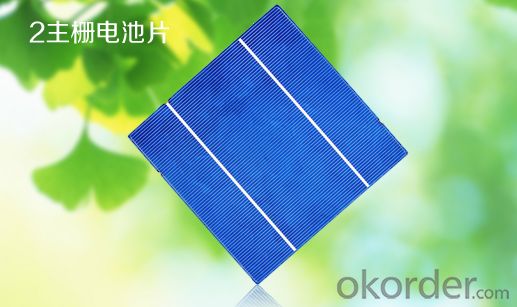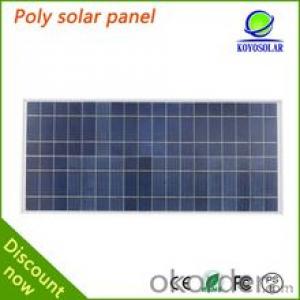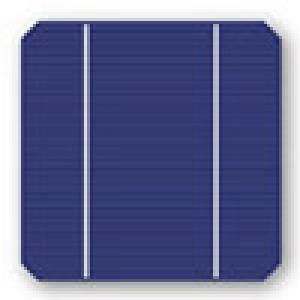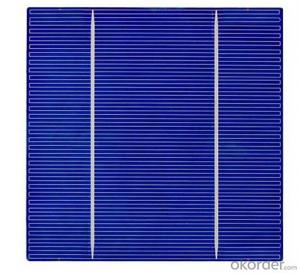Anti Reflective Coating PV Poly 2BB Solar Cells
- Loading Port:
- China Main Port
- Payment Terms:
- TT OR LC
- Min Order Qty:
- -
- Supply Capability:
- -
OKorder Service Pledge
OKorder Financial Service
You Might Also Like
THE CHARACTERISTIC OF 156P POLY-SILICON SOLAR CELLS
1.Format 156mm×156mm±0.5mm,Thickness 210μm±30μm.
2.High efficiency in photovoltaic conversion 16.3%~17.93%;
3.Low inverse current, high shunt resistance and high dependability.
4.Front(-): covered by dark blue silicon nitride anti-reflecting coating(silicon nitride) with bus bars(silver), 2/3/5 bud bars(silver).
5.Back(+): wide soldering pads(silver), back surface field(aluminum),high quality paste for the BSF and the electrode ensure higher tension and improve soldering easiness.

- Q: What is the role of disconnect switches in solar cell systems?
- Disconnect switches in solar cell systems play a crucial role in ensuring the safety and efficient operation of the system. They act as a means of isolating the solar panels from the rest of the system, allowing for maintenance and repairs without the risk of electric shock or damage. Disconnect switches also serve as a protective measure in case of emergencies, enabling rapid shutdown of the entire system to prevent further damage or hazards.
- Q: Are solar cells impacted by shading?
- Yes, solar cells are impacted by shading. Even a small amount of shading can significantly reduce the efficiency and output of solar cells. Shading blocks sunlight from reaching the cells, which disrupts the flow of electrons and decreases the overall power generation. It is important to ensure that solar panels are installed in areas with minimal shading to maximize their performance.
- Q: What is a thin-film solar cell?
- A thin-film solar cell is a type of solar cell that is made by depositing one or more thin layers of photovoltaic material onto a substrate. These cells are typically flexible, lightweight, and have a lower manufacturing cost compared to traditional silicon-based solar cells. They can be used in a variety of applications, such as solar panels for buildings, portable electronic devices, and even integrated into clothing or other surfaces.
- Q: How do solar cells perform in extreme temperatures?
- Solar cells generally perform less efficiently in extreme temperatures. High temperatures can cause solar cells to heat up, leading to a decrease in their electrical output. Similarly, extremely cold temperatures can also impact the performance of solar cells, reducing their efficiency. However, modern solar cell technologies are designed to minimize the effects of temperature on their performance, and many solar panels are equipped with built-in temperature management systems to maintain optimal operation.
- Q: Can solar cells be used for powering communication systems?
- Yes, solar cells can be used for powering communication systems. Solar cells convert sunlight into electricity, which can be used to power various devices, including communication systems. This makes them a sustainable and environmentally-friendly option for powering such systems in remote or off-grid locations.
- Q: Can solar cells be used in off-grid applications?
- Yes, solar cells can be used in off-grid applications. Off-grid applications refer to situations where there is no access to the traditional electricity grid. Solar cells, also known as photovoltaic cells, convert sunlight directly into electricity, making them a reliable source of power for off-grid applications. They can be used to generate electricity for various purposes, such as powering homes, buildings, or remote installations in areas without access to the grid.
- Q: What is the role of solar cells in powering electric vehicles?
- Solar cells play a crucial role in powering electric vehicles by harnessing sunlight and converting it into electricity. They are typically installed on the roof of the vehicle, or integrated into its body, and generate renewable energy which can be used to charge the vehicle's battery. While solar power alone may not be sufficient to fully power an electric vehicle, it can significantly extend its range and reduce the reliance on grid electricity. Additionally, solar cells provide a sustainable and environmentally friendly solution, contributing to the overall goal of reducing carbon emissions and promoting clean energy transportation.
- Q: How do solar cells handle shading or obstructions?
- Solar cells handle shading or obstructions by bypassing the shaded or obstructed areas and maximizing energy production from the unshaded portions of the cell.
- Q: How do solar cells perform in regions with high levels of dust and sandstorms?
- Solar cells may experience decreased performance in regions with high levels of dust and sandstorms. The accumulation of dust particles on the surface of solar panels can reduce their efficiency by blocking sunlight and reducing the amount of energy they can generate. Regular cleaning and maintenance of solar panels are essential in such environments to ensure optimal performance. Additionally, advancements in solar panel technology, such as anti-soiling coatings, are being developed to mitigate the impact of dust and sandstorms on solar cell performance.
- Q: How do solar cells handle lightning strikes or electrical surges?
- Solar cells are designed to handle lightning strikes or electrical surges by incorporating protective measures into their design. These measures often include surge protection devices, such as varistors or lightning arrestors, which divert excessive electrical energy away from the solar cells and into a grounding system. This helps to prevent damage to the cells and the overall solar system, ensuring their safe operation even during such events.
Send your message to us
Anti Reflective Coating PV Poly 2BB Solar Cells
- Loading Port:
- China Main Port
- Payment Terms:
- TT OR LC
- Min Order Qty:
- -
- Supply Capability:
- -
OKorder Service Pledge
OKorder Financial Service
Similar products
Hot products
Hot Searches
Related keywords























